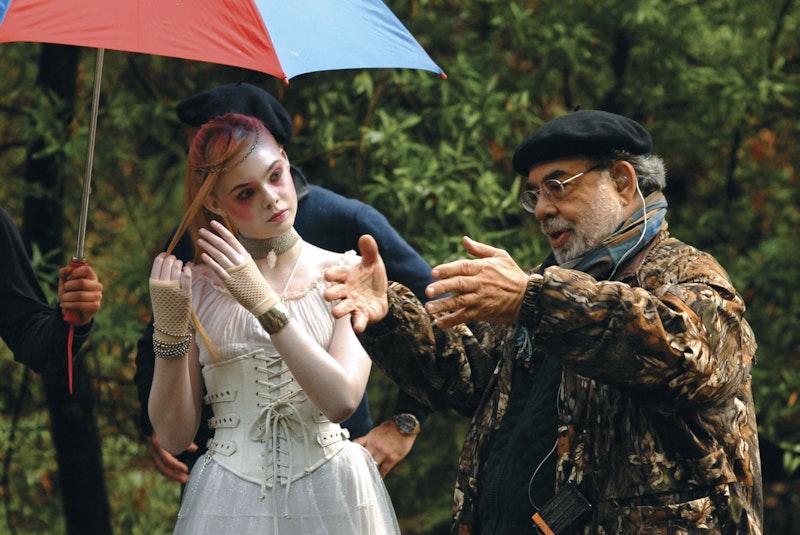Just over a year ago I wrote my first piece for Paste about the use of Sony’s revolutionary digital cinema camera, the HDW-F900, and how two films that played at Cannes in 2002, Star Wars: Attack of the Clones and Aleksandr Sokurov’s Russian Ark, suggested the new possibilities of digital filmmaking—the former looking to reinvent the on-set and post-production processes of studio filmmaking, and the latter pursuing a new kind of digital veracity through previously impossible long-takes. While these films are interesting comparisons for being so fundamentally different in form, content, and philosophy, I’ll make an addendum here looking at one of the first released features shot on the F900 and, as far as I can tell, the very last: Shunji Iwai’s experimental teen melodrama All About Lily Chou-Chou and Francis Ford Coppola’s digital Zoetrope coda Twixt.
All About Lily Chou-Chou was originally published as a series of forum posts on a fan site about a fictional pop star, with Iwai posting as multiple characters. It seems natural then that the novelizing of the new digital spaces people were inhabiting would be brought to the screen through new digital technologies. Taking cues from his friend Hideaki Anno’s first live-action film Love & Pop (Iwai would also star in Anno’s second live-action feature Ritual), the mobility of digital cameras allowed for a type of unfettered cinematography not seen since 16mm cameras became staples of new wave movements in the 1960s. Text forms itself across the screen as it cuts back and forth between black voids and stark, gliding images of bodies in spaces. What’s remarkable about Iwai’s aggressive form is that it seeks to externalize the new internal realities of the internet age not through information but raw emotion. Even two decades later, text on screen has never been so violent, such an intrusion to the image but concordant with its emotion. Perhaps it’s because everything, from the typed characters to the blades of grass rolling in the wind, is filtered through the same 1s and 0s.
Ten years after Lily Chou-Chou and three decades after his career as a renegade innovator seemingly collapsed, Francis Ford Coppola was rounding out a digitally-shot trilogy at his estate in Napa. Having not directed a feature since 1997, Coppola acquired a F900 for his (probably too) experimental film Youth Without Youth, and would use it again for Tetro and Twixt as a means to make a “conventional” production a lot cheaper. On the surface just a cheap piece of regional pulp, Twixt is a personal collision of memory (past), reality (present), and dreams (future). The character and the filmmaker get increasingly blurred—to the point where the story’s catharsis is the hack horror writer reconciling with the freak accidental death of his child, killed in the exact, tragic way as Coppola’s oldest son Gian-Carlo. Coppola said the movie came to him in a raki-induced dream after being awoken by a call to prayer in Istanbul, and as the film progresses it feels less like an adaptation of a dream and more like we’re peering into Coppola’s actual subconscious. Part of this is its oneiric narrative, but at the same time the digital texture renders the rolling hills of northern California as a land of unreality, compressed into color bits onto the wholly flat emulsion of a digital sensor.
If there’s one quality of the F900 that kept its “digital cinema” label from transcending the “digital” part it's that physical flatness. One of the magic things about photochemical film is its physicality, the light passing through something on onto another—there’s a depth and volume to it. Even as the digital sensors have gotten larger, to the point where full-frame (aka, the size of a piece of 35mm film) has become the standard for consumers, even Sony’s more recent IMAX-sized iterations of their CineAlta series that birthed the F900 can’t match its photochemical counterpart in depth. While it’s basically ugly by conventional measures, that transitional digital cinema has a kind of beautiful, surreal quality that can’t be replicated by other means. That crunched image becomes a gorgeously warped flat circle with Iwai’s wide lenses or a hyper-compressed reality in Coppola’s telescopic eye, where somehow the entire image is in focus like the entirety of the world was a matte painting. What was branded as the coming of a new kind of filmmaking did coalesce into the same-old studio work, but, not unlike the Nūberu bāgu or New American Cinema, they did get a good decade of experimentation out of it.

